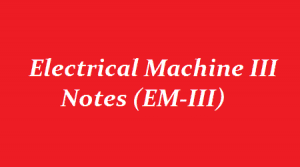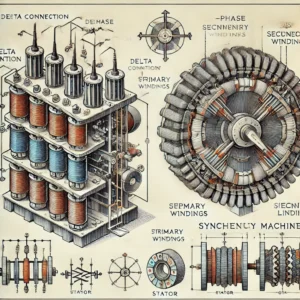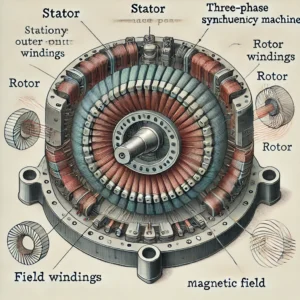EM 3 Notes Pdf – Electrical Machines 3 JNTUH Download Free Lecture Notes
Here you can download the free lecture Notes of Electrical Machines 3 Pdf Notes – EM III Notes Pdf materials with multiple file links to download. The Electrical Machines 3 Notes pdf – EM III Notes Pdf book starts with the topics covering Constructional Features of round rotor and salient pole machines, suppression of harmonics, Regulation by synchronous impedance method, Parallel Operation of Synchronous Generator Synchronizing alternators with infinite bus bars, Theory of operation, Excitation and power circles, Single phase induction motor, Principle & performance of A.C. Series motor-Universal motor, Etc.

Electrical Machines 3 Pdf Notes – EM III Notes Pdf
Objective : Electrical Machines 3 Notes – EM III Notes
This subject is an extension of previous machines courses. It deals with the detailed analysis of Synchronous generators and motors which are the prime source of electrical power generation and its utilities. Also concerns about the different types of single phase motors which are having significant applications in house hold appliances and control systems.
Latest Material Links
Complete notes
Link – Complete Notes
Unit 1
Link – Unit 1 Notes
Unit 2
Link – Unit 2 Notes
Unit 3
Link – Unit 3 Notes
Unit 4
Link – Unit 4 Notes
Unit 5
Link – Unit 5 Notes
Old Material Links
Complete Notes :-
Download EM-III Notes here
UNIT – I
Construction and Principle of operation
Constructional Features of round rotor and salient pole machines – Armature windings – Integral slot and fractional slot windings; Distributed and concentrated windings – distribution, pitch and winding factors – E.M.F Equation.
UNIT-II
Synchronous Generator Characteristics
Harmonics in generated e.m.f. – suppression of harmonics – armature reaction – leakage reactance – synchronous reactance and impedance – experimental determination – phasor diagram – load characteristics.
UNIT – III
Regulation of Synchronous Generator
Regulation by synchronous impedance method, M.M.F. method, Z.P.F. method and A.S.A. methods – salient pole alternators – two reaction analysis – experimental determination of Xd and Xq (Slip test) Phasor diagrams – Regulation of salient pole alternators.
UNIT – IV
Parallel Operation of Synchronous Generator Synchronizing alternators with infinite bus bars – synchronizing power torque – parallel operation and load sharing – Effect of change of excitation and mechanical power input. Analysis of short circuit current wave form – determination of sub-transient, transient and steady state reactances.
Electrical Machines III Notes (EM III)
UNIT – V
Synchronous Motors – Principle of Operation
Theory of operation – phasor diagram – Variation of current and power factor with excitation – synchronous condenser – Mathematical analysis for power developed .
UNIT-VI
Power Circles
Excitation and power circles – hunting and its suppression – Methods of starting – synchronous induction motor.
UNIT – VII
Single Phase Motors
Single phase Motors: Single phase induction motor – Constructional features-Double revolving field theory –Equivalent Circuit – split-phase motors – Capacitor start capacitor run motors.
UNIT – VIII
Special Motors
Electrical Machines 3 Notes PDF – EM III Notes PDF | JNTUH B.Tech Notes 2025


Are you pursuing B.Tech and looking for comprehensive notes on Electrical Machines 3 (EM III)? Look no further! In this article, we provide you with the Electrical Machines 3 Notes PDF specifically designed for JNTUH students. These notes are a valuable resource for your academic preparation, covering all the important concepts of Synchronous generators, motors, and single-phase motors. Available for free download, these notes will be your go-to material for acing exams. Read on to learn more about the content and download links.
EM III Notes PDF
The EM III Notes PDF for Electrical Machines 3 is available for all units and covers every crucial topic necessary for a detailed understanding of electrical machines. From the constructional features of round rotor and salient pole machines to advanced concepts like parallel operation of synchronous generators and power circles, these notes provide a structured approach to mastering the subject.
Electrical Machines 3 PDF Lecture Notes – JNTUH
The Electrical Machines 3 Notes offered by JNTUH are tailored to the R13 syllabus. These lecture notes break down complex topics into simple, understandable modules, allowing students to grasp key concepts easily. Each unit is meticulously designed with clear explanations, phasor diagrams, mathematical formulations, and performance analysis.
Electrical Machines 3 Notes, PDF | EM III B Tech (2025)
Electrical Machines 3 (EM III) is an essential subject for B.Tech students, focusing on synchronous machines and single-phase motors, which are fundamental in the field of electrical power generation and its applications. This subject offers in-depth coverage of the construction, working principles, and performance characteristics of synchronous generators and motors.
Electrical Machines 3 (EM III) | PDF, Syllabus, Books | B Tech (2025)
Overview – EM III Notes PDF
The Electrical Machines 3 Notes PDF contains all the important notes, lecture materials, and solved examples necessary for understanding the concepts of electrical machines. It includes detailed diagrams, derivations, and step-by-step explanations of critical topics like:
- Constructional features of synchronous machines
- Regulation of synchronous generators
- Parallel operation and load sharing of alternators
- Single-phase induction motors and their applications
These notes will help you prepare for your exams, lab experiments, and even competitive exams like GATE.
The Following Topics Are Covered in Electrical Machines 3 Handwritten Notes
- Constructional Features of round rotor and salient pole machines
- Suppression of harmonics
- Regulation by synchronous impedance method
- Parallel Operation of Synchronous Generators
- Synchronizing alternators with infinite bus bars
- Excitation and power circles
- Single-phase induction motors
- A.C. Series motor and Universal motor
Links to Download EM III Notes PDF
- Complete Notes: Download Full Notes PDF
- Unit 1 Notes: Download Unit 1 PDF
- Unit 2 Notes: Download Unit 2 PDF
- Unit 3 Notes: Download Unit 3 PDF
- Unit 4 Notes: Download Unit 4 PDF
- Unit 5 Notes: Download Unit 5 PDF
EM 3 Notes and Study Material PDF Free Download
If you’re a student from JNTUH or any university that follows a similar syllabus, these Electrical Machines 3 Notes PDF will be incredibly useful for your studies. You can easily download the material from the links provided above. These notes offer detailed insights into each module, ensuring you cover all the important topics comprehensively.
Topics Covered in This EM III Notes PDF
- Unit I – Construction and Principle of Operation
Covers the basics of synchronous generators, focusing on armature windings, EMF equations, and various types of windings. - Unit II – Synchronous Generator Characteristics
Discusses harmonics in generated EMF, armature reaction, and synchronous impedance. - Unit III – Regulation of Synchronous Generator
Includes methods for regulation such as synchronous impedance method, M.M.F. method, and slip test for determining reactance. - Unit IV – Parallel Operation of Synchronous Generators
Focuses on synchronizing alternators, analyzing short circuit current waveforms, and determining reactances. - Unit V – Synchronous Motors
Explains the principle of synchronous motor operation, including power factor variations and synchronous condensers. - Unit VI – Power Circles and Hunting Suppression
Covers excitation power circles and hunting, including starting methods for synchronous motors. - Unit VII – Single Phase Motors
Focuses on split-phase motors, capacitor start motors, and equivalent circuits of single-phase induction motors. - Unit VIII – Special Motors
Discusses A.C. series motors, universal motors, permanent magnet motors, and reluctance motors.
EM III Notes PDF from JNTUH
These notes are specifically tailored for JNTUH (Jawaharlal Nehru Technological University, Hyderabad) students, and are aligned with the R09 and R13 syllabus. The comprehensive material ensures that all critical topics are covered in detail, from synchronous machines to single-phase motors.
Always Choose Smartzworld to Download EM 3 Notes PDF
Smartzworld offers high-quality, well-structured notes that are designed to aid students in their exam preparation. The website is known for its easy-to-access links and clear categorization of notes by units and topics.
Benefits of FREE EM III Handwritten Notes PDF
- Detailed Diagrams: All key concepts are explained with the help of diagrams, making it easier to visualize the working of electrical machines.
- Step-by-Step Explanations: Topics are broken down into simple steps to facilitate easier understanding.
- Free Download: These notes are available for free download, saving you both time and money.
- Comprehensive Coverage: The notes cover all units and topics as per the JNTUH syllabus.
FAQs: Electrical Machines 3 Notes (EM III)
Q1. Where can I download the Electrical Machines 3 Notes PDF?
You can download the notes from the provided links for each unit or the complete set from Smartzworld.
Q2. How to download the EM III Notes PDF?
Simply click on the download links provided above to access the notes for each unit.
Q3. How many modules are covered in EM III Notes PDF?
The EM III Notes cover 8 units as per the JNTUH R09 syllabus, which has been consolidated into 5 units in the R13 syllabus.
Q4. Topics Covered in EM III Notes PDF?
The topics include synchronous generators, single-phase motors, parallel operation, power circles, and special motors.
Q5. Where can I get the complete EM III Handwritten Notes PDF FREE Download?
You can download the complete handwritten notes for free from the provided links above.
Q6. How to Download FREE EM III Notes PDF?
Click on the download links provided to get access to the notes for free.
Q7. How to Download FREE EM III Handwritten Notes PDF?
You can download the handwritten notes from Smartzworld using the direct download links shared above.
By downloading these Electrical Machines 3 (EM III) Notes, you will have a solid foundation in the subject, which is essential for both academic success and professional growth in the field of electrical engineering.
Principle & performance of A.C. Series motor-Universal motor – Principle of permanent magnet and reluctance motors.
TEXT BOOKS:
- Electric Machines – by I.J.Nagrath & D.P.Kothari, Tata Mc Graw-Hill Publishers, 7th Edition 2005.
- Electrical Machines – by P.S. Bimbra, Khanna Publishers.
REFERENCE BOOKS:
- The Performance and Design of A.C.Machines – by M.G.Say, ELBS and Ptiman & Sons.
- Electric Machinery – by A.E. Fitzgerald, C.Kingsley and S.Umans, Mc Graw-Hill Companies, 5th edition, 1990.
- Theory of Alternating Current Machinery by Langsdorf, Tata Mc Graw-Hill, 2nd edition.
- Electromachanics-III (Synchronous and single phase machines), S.Kamakashiah, Right Publishers
Note :- These notes are according to the r09 Syllabus book of JNTUH.In R13 ,8-units of R09 syllabus are combined into 5-units in r13 syllabus.Click here to check all the JNTU Syllabus books
